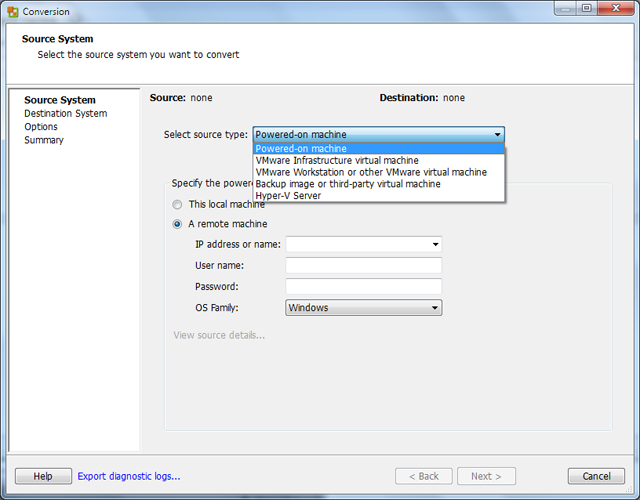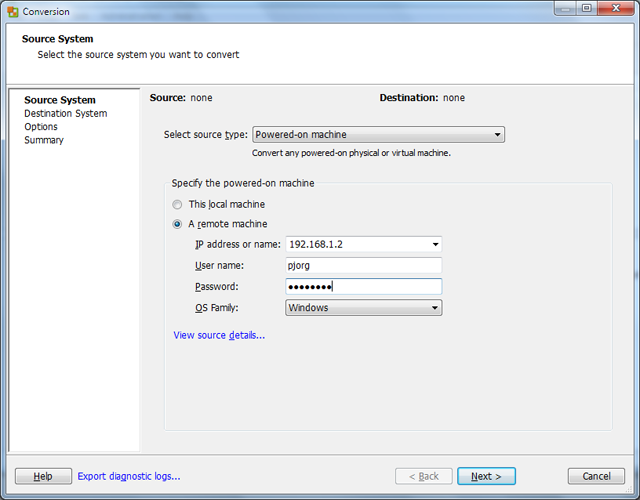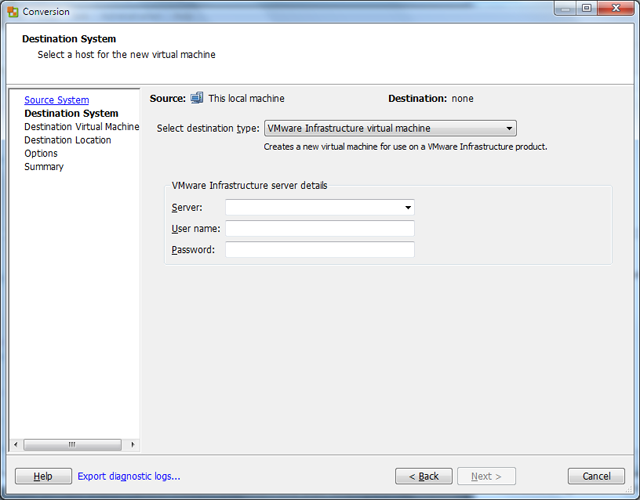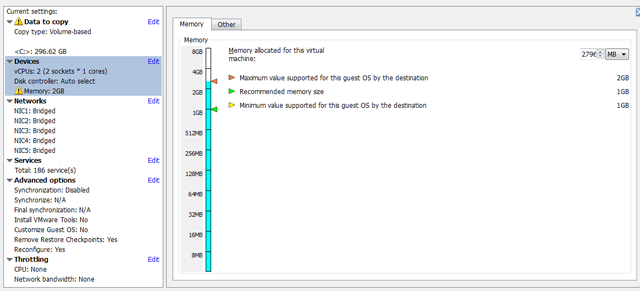How to Upload Vm to Esxi Server
Writer: Petra Jorgenson
Edifice a virtual machine from scratch can accept several hours. Setting upwardly the hardware parameters, installing the operating system, and then adding 3rd-party applications to the OS can exist a huge time sink. Fortunately, you can reduce the amount of time spent creating and configuring virtual machines past cloning and importing physical or virtual systems to your VMware ESX/ESXi server.
VMware vCenter Converter: P2V and V2V
VMware vCenter Converter is an awarding developed to migrate systems. The application converts and packages a source organization into a new virtual machine that tin reside on an ESX/ESXi server.
vCenter Converter performs both physical-to-virtual (P2V) and virtual-to-virtual (V2V) migrations. In a P2V migration, the operating arrangement running on a concrete organization is copied to a virtual motorcar. In a V2V migration, an existing virtual machine running on 1 virtualization platform is copied to a virtual automobile running on another virtualization platform. But vCenter Converter is not limited to virtual machines created in VMware platforms; it can also import and convert VMs created in competing software, such equally Microsoft Virtual Server and Microsoft Hyper-V.
In function one of this series, you lot'll learn how to do a P2V migration; in part two, you'll learn how to do V2V.
Hot vs Cold Migrations
VMware vCenter Converter is capable of accomplishing both hot migrations and cold migrations.
Hot migrations are those which occur while the source system is in a running state. Hot migrations are not recommended for certain tasks – similar migrating Active Directory Domain Controllers into a virtual machine (this job should be performed during a cold migration) – just work well with systems where local information remains static.
Cold migrations, on the other hand, occur while the source arrangement is offline. Common cold migrations are ideal for systems like SQL servers and mail servers that take information that is regularly updated or altered. During cold migrations, the physical computer itself is yet running, but the operating organization that is beingness cloned is inactive. Common cold migrations are initiated by booting VMware Converter from a disc.
In today's article we'll take a look at how to perform a hot P2V migration and a cold P2V migration.
P2V: Hot Migration
1. To perform a P2V migration in vCenter Converter Standalone, click "Convert Machine." Select "Powered-on Machine" from the drop-downwards menu on the Source Organisation tab.

two. Select "This Local Machine" if you intend to migrate the concrete machine to where VMware vCenter Conversion is installed. Otherwise, click "A Remote Machine" and and then enter the IP address and login credentials for the source system. Click "Side by side."

three. Select "VMware Infrastructure Virtual Motorcar" from the drop-down menu. Enter the server address and login credentials for the organization running VMware ESX/ESXi. Click "Next."

4. Review the system parameters on the Options tab. To make changes to a device, network or service option, select the desired setting from the list.
Click "Advanced Options" to synchronize the source system with the destination arrangement immediately after cloning or at a scheduled date and time. If y'all're cloning a Windows machine, it'south recommended that you check "Install VMware Tools on the Destination Virtual Machine" and "Remove System Restore Checkpoints on Destination" on the Post-Conversion tab.
Click "Side by side" after making the desired modifications, if applicable.

- Review your configuration on the Summary tab; then click "Finish" to perform the migration.
P2V: Cold Migration
one. Boot to VMware Converter, and so click "Import Machine" from the toolbar. Click "Adjacent"; then click "Physical Computer." Click "Next" again.
two. Select "A Remote Machine" or "This Local Auto" on the Source Login screen. If selecting "A Remote Automobile," enter the name or IP address for the source system; then enter the login credentials. Click "Side by side."
3. Select "Automatically Uninstall the Files When Import Succeeds" if prompted, then click "Yes" to continue. On the Source Information screen, select "Convert All Disks and Maintain Size" to import an identical hard deejay configuration to the destination machine. To brand modifications to the deejay configuration, click "Select Volumes and Resize to Save or Add Space."
Uncheck a book to remove it from the migration. To specify a new volume size for a deejay, select the drop-downwards carte du jour below "New Disk Infinite." Cull "Maintain Size" to utilise the original volume size or cull "Min(imum) Size" to import only the part of the disk that has been used. You can as well manually specify the size of the disk by typing the desired capacity in GB or MB.
4. Select "VMware Infrastructure Virtual Machine" from the drop-down menu on the Destination Blazon screen. Click "Next." Enter the server address and the login credentials for the ESX/ESXi server.
5. Name the destination system. Click "Next." Select the preferred host to run the virtual machine from. Click "Next" once more.
vi. Select a datastore for the virtual automobile. The datastores should be large plenty to concord the information stored to the source system's hard disks. To assign a datastore to each hard disk, click "Avant-garde"; and then select a datastore for each hard disk drive and config file. Click "Adjacent."
7. Select the number of network interface cards (NICs) to import. Check "Connect at Power On," if preferred. Click "Side by side." Check "Install VMware Tools," "Customize the Identity of the Virtual Motorcar," and "Remove All System Restore Checkpoints." Click "Next."
8. On the Computer Info screen, enter the reckoner, owner and system names. Generate a new security identity (SID), if desired, then blazon the location where the Sysprep files are stored, if applicable. Click "Next." If you're importing a Windows system, enter the licensing information for the car. Click "Next."
9. Select a time zone from the drib-down menu. Click "Next." Select a NIC and then click "Customize," to alter the network parameters, if preferred; otherwise, utilise the default settings. Click "Side by side."
10. Enter the workgroup or Windows server domain information on the Workgroup or Domain screen. Input the necessary login credentials; then click "Side by side."
11. Review your settings on the Summary screen. To power on the destination VM subsequently completing the conversion, check "Ability on the New Virtual Machine Later Creation." Click "End" to begin importing the source system to the ESX/ESXi server machine.
Role 2: V2V Migration
I hope this commodity volition help yous learn how to perform a hot and cold P2V migration using the VMware vCenter Converter. In my next article nosotros'll get over a V2V migration.
Related tags:
it-ops vmware virtualization esxi
About the author
Petra Jorgenson is a professional person writer with over six years of It experience. She specializes in reckoner architecture, operating systems, networking, virtualization and web pattern. She has written support documentation for a leading BSS/OSS system and has over 100 published manufactures addressing a multitude of technology-related topics. Jorgenson is working on obtaining her MCITP certification.
courticechand1991.blogspot.com
Source: https://www.allhandsontech.com/it-ops/vmware/importing-virtual-machines-into-vmware-esxi/
0 Response to "How to Upload Vm to Esxi Server"
Post a Comment